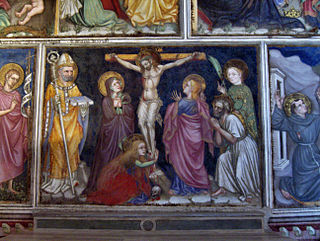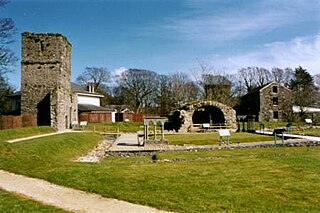This article relies largely or entirely on a single source .(December 2010) |
John Grierson or Grisson (died 1564) was a Scottish Dominican and perhaps a member of the family of Grierson of Lag in Dumfriesshire.
This article relies largely or entirely on a single source .(December 2010) |
John Grierson or Grisson (died 1564) was a Scottish Dominican and perhaps a member of the family of Grierson of Lag in Dumfriesshire.
Grierson was a student of the university of Aberdeen, and in 1500 was principal of the King's College at that university. Previously to 1517 he became prior of the Dominican house at St. Andrews, and rose to be provincial of his order in Scotland before 1528. In 1542 he is described as doctor of divinity, provincial, and prior of St. Andrews; he resigned the priory before 1552. He was certainly alive in 1559, and is said to have survived till 1564. Echard says that he remained a firm Roman Catholic, and defended his faith by word and by deed.
According to Dempster, Grierson wrote:
Some letters which are preserved in R. F. Plaudius's history of the order. But Echard says that he had searched in vain for these letters, and it is possible that Grierson left no writings.

Pope Benedict XI, born Nicola Boccasini, was head of the Catholic Church and ruler of the Papal States from 22 October 1303 to his death.

Jacopo De Fazio, best known as the blessed Jacobus de Varagine, or in Latin Voragine was an Italian chronicler and archbishop of Genoa. He was the author, or more accurately the compiler, of Legenda Aurea, the Golden Legend, a collection of the legendary lives of the greater saints of the medieval church that was one of the most popular religious works of the Middle Ages.

Hugh of Saint-Cher, O.P. was a French Dominican friar who became a cardinal and noted biblical commentator.
John of Vercelli was the sixth Master General of the Dominican Order (1264-1283).
Durandus of Saint-Pourçain was a French Dominican, philosopher, theologian, and bishop.
In the Roman Catholic Church, Theologian of the Pontifical Household is a Roman Curial office which has always been entrusted to a Friar Preacher of the Dominican Order and may be described as the pope's theologian. The title was formerly known as the Master of the Sacred Apostolic Palace before the changes implemented in Pope Paul VI's 1968 apostolic letter Pontificalis Domus.
Clement was a 13th-century Dominican friar who was the first member of the Dominican Order in Britain and Ireland to become a bishop. In 1233, he was selected to lead the ailing diocese of Dunblane in Scotland, and faced a struggle to bring the bishopric of Dunblane to financial viability. This involved many negotiations with the powerful religious institutions and secular authorities which had acquired control of the revenue that would normally have been the entitlement of Clement's bishopric. The negotiations proved difficult, forcing Clement to visit the papal court in Rome. While not achieving all of his aims, Clement succeeded in saving the bishopric from relocation to Inchaffray Abbey. He also regained enough revenue to begin work on the new Dunblane Cathedral.

Patrick Forbes was a late 16th-century and early 17th-century Scottish churchman.

John Winram was a 16th-century Scottish priest and ecclesiastical reformer. He was born in 1492, the son of one James Winram of Ratho and his wife Margaret Wilkie. He obtained a Bachelor's Degree (1515), a Master's Degree and a Doctorate (1541) from St Leonard's College, University of St Andrews.
Henry Sinclair (1508–1565) was a Scottish lord-president of the court of session and bishop of Ross.
John Bullock O.S.A. was an Augustinian canon and prelate active in the 15th century Kingdom of Scotland. While earning a university degree between 1409 and 1417, Bullock gained several benefices in Scotland, and claimed the headship of St Andrews Cathedral Priory before becoming Bishop of Ross in 1418. He held the latter position until his death, which occurred in either 1439 or 1440.
Bartolomeo Spina was an Italian Dominican theologian and scholastic philosopher.

William Russell was a fourteenth-century Cistercian prelate. He appears to have begun his career as a Cistercian monk at Rushen Abbey on the Isle of Man (Mann), ascending to the rank of abbot there, before being elected Bishop of Mann and the Isles (Sodor). After traveling to Continental Europe for confirmation and consecration, avoiding a trip to the metropolitan in Norway, he returned to the Irish Sea as a legal bishop. A few things are known of his episcopate, particularly his activities in England and a series of provincial statutes apparently promulgated under his leadership.

Venturino of Bergamo was an Italian Dominican preacher.
Hentenius was a Flemish Dominican Biblical exegete. He is well known for his edition of the Vulgate in 1547.
Serafino Porrecta was an Italian Dominican theologian.
John Grierson was a Scottish documentary filmmaker.

John Craig was a Reformer, and colleague of John Knox. Originally a Dominican, he became a Church of Scotland minister with significant extra responsibilities and played an influential part in the Scottish Reformation.
Thomas Worthington (1671−1754), was a Dominican friar and writer. He received his education in the college of the English Jesuits at St. Omer. In 1691, he entered the Dominican Order at the convent of Bornhem in Flanders, and in the following year he made his solemn confession as a member of the order. He was ordained priest at Rome in 1695, and went afterwards to the college of St. Thomas Aquinas at Louvain, where he became successively professor of philosophy, theology, and sacred scripture. He graduated B.D. in 1704, was elected prior of Bornhem in 1705, and re-elected in 1708, and was instituted prior provincial of England. For nine years he laboured on the English mission, sometimes in London, but generally in Yorkshire and Lancashire. On his return to Flanders, he was again installed prior of Bornhem, 25 January 1717−18. He was created D.D. in 1718, was elected prior of Bornhem for the fifth time in 1725, and was again instituted provincial on 4 January 1725−6. Subsequently he became chaplain at Middleton Hall, the residence of Ralph Brandling, in the parish of Rothwell, near Leeds. He died there on 25 February 1754 (N.S.)
John of St. Giles was an English Dominican friar and physician.
. Dictionary of National Biography . London: Smith, Elder & Co. 1885–1900.